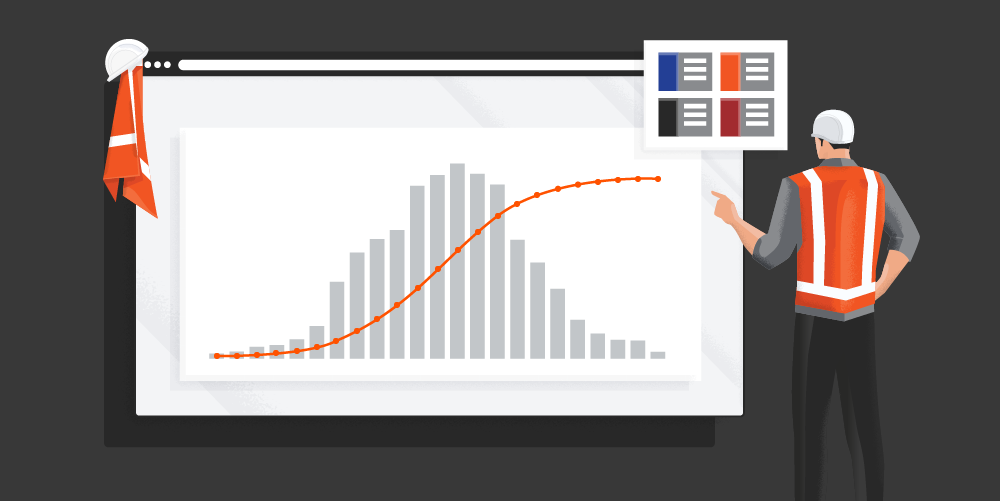— 9 min read
How to Manage Cash Flow Throughout the Construction Lifecycle
Last Updated Aug 7, 2024
Last Updated Aug 7, 2024

Navigating the financial ebbs and flows of construction projects demands a deep understanding of how to manage cash flow.
Cash flow management in construction is the practice of overseeing and optimizing the balance between the funds coming into and going out of a project. It's about ensuring there is enough cash available to meet the project's immediate needs — such as paying for labor, materials and equipment — while also securing timely payments from clients. This process requires careful planning, monitoring of income and expenditures and strategic timing of payments to maintain financial stability and prevent project delays or the need for emergency funding.
In this article, we’ll examine the ins and outs of measuring and managing cash flow in construction, including tips on how to maintain positive cash flow on projects.
Table of contents
What is cash flow?
Cash flow in construction refers to the movement of funds into and out of a construction project over a specific period. It's the lifeblood of any construction project, determining its financial health and operational viability. Essentially, it tracks the cash that flows in from clients and financing sources against the cash that flows out for project expenses like labor, materials subcontractor payments and equipment costs.
A robust cash flow ensures that work on the construction site continues uninterrupted. Without it, payments to workers and suppliers are delayed, leading to halted operations and potentially causing the project to stall. Maintaining a positive cash flow is not just about balancing the books but about ensuring that the work progresses and the job site remains active and productive.
Cash flow management takes on heightened significance in the construction industry due to the long-term nature of projects with significant upfront costs and staggered income. Payments from clients typically come in stages, often linked to project milestones or the percentage of work completed, while expenses need to be covered continuously. This creates a situation where managing the timing and amount of cash inflows and outflows becomes critical.
A positive cash flow means that a construction project is receiving more money than it is spending, which is essential for keeping a project moving forward without interruption. This status allows a construction firm to cover its bills on time, invest in necessary resources and even save for future projects. On the other hand, a negative cash flow indicates that a project is spending more money than it is bringing in, leading to potential delays, the need for additional financing, or, in the worst cases, halting the project entirely.
Strategies to Maintain Positive Cash Flow
Achieving and sustaining a positive cash flow is a key component of financial health on construction projects and requires strategic foresight and diligent management.
Let’s examine some practical tips and strategies designed to help construction professionals navigate the financial complexities of keeping cash flow robust and projects on track. From optimizing billing practices to managing expenses and leveraging technology, these insights aim to bolster a project's cash position.
Get the Financial Guide to Commercial Growth
Learn more about key financial challenges before and during periods of expansion in commercial construction -- and strategies to tackle them.

1. Leverage cash flow projection reports.
Utilizing cash flow projection reports is crucial for effectively managing and forecasting future cash positions. These reports provide valuable insights into upcoming cash inflows and outflows, allowing construction firms to plan ahead and make informed decisions.
By regularly updating and reviewing these projections, companies can anticipate potential shortfalls or surpluses and adjust their strategies accordingly. This proactive approach to cash management helps ensure financial stability and supports strategic decision-making for future project planning and investment.
2. Implement a pay-when-paid clause in contracts.
Maintaining a healthy cash flow requires ensuring invoices are approved upstream (by clients) before approving downstream invoices (for example, to subcontractors and suppliers). Incorporating a "pay-when-paid" clause — which is common in Guaranteed Maximum Price (GMP) contracts — is an effective strategy. This clause means that subcontractors and suppliers are paid only after the general contractor has received payment from the client, aligning cash outflows with inflows and helping to mitigate the risk of cash shortages.
3. Diversify your work portfolio.
Relying heavily on a single large contract poses a significant financial risk, especially for subcontractors due to the "pay when paid" clause that is common in many contracts. The real danger of this financial dependence becomes all too clear when unexpected delays in payment occur, which can have catastrophic effects on a business's cash flow and overall viability.
For example, consider a painting subcontractor engaged in a massive $2 million project and found themselves in a bind with $400,000 worth of frozen payments were frozen for six months due to disagreements between the general contractor and the project owner. This project constituted a major portion of the subcontractor's business, making the delayed payment not just a setback but a critical blow to the company's overall financial health.
As the payment delay extended, the painting subcontractor found themselves unable to pay their workers. Without the necessary compensation for their time, the painters stopped coming to work, halting progress on the project. This standstill not only affected the immediate job but also the contractor's reputation and ability to secure future work. Eventually, the lack of cash flow, compounded by the inability to complete work and generate income, led to the business's downfall. This stark example illustrates the domino effect that can result from over-reliance on a single source of income, especially in an industry where cash flow is the engine of daily operations. It emphasizes the importance for construction firms to maintain a diversified portfolio of projects, spreading financial risk and ensuring that the failure or delay of one project does not jeopardize the entire business.
4. Understand the true cost of capital
The cost of capital, whether it's in the form of interest on loans or reduced profit margins from early payment discounts, should be carefully weighed. Firms should strategize to optimize their cash reserves and manage their payment terms in a way that balances the need for immediate liquidity with the overarching goal of maintaining or enhancing profitability. By doing so, they can avoid the expensive trap of relying too heavily on costly financing options or concessions to generate quick cash, preserving their financial health and ensuring sustainable growth.
5. Implement a robust job costing process.
Integrating a sophisticated job costing system, enhanced by the use of cost codes, is a key piece of managing the cash flow of current and future projects effectively. This system tracks every expense related to current jobs, providing real-time visibility into cash outflows, while also allowing the analysis of historical project data to inform future cash flow projections.
Utilizing cost codes assigns specific expenses to distinct categories, offering a detailed view of where and how funds are being spent. This level of detail aids in identifying potential cash flow issues early on and facilitates strategic decisions based on past performance trends. By leveraging both current and historical job cost data, construction firms can navigate the financial landscape with greater precision and accuracy, ensuring a healthier cash flow management strategy.
6. Establish an effective invoicing system.
An effective invoicing system enables quick identification of discrepancies between the amounts billed to the owner and the costs incurred on the project. By quickly identifying differences between billed amounts and incurred expenses, construction companies can address billing errors, disputes, or omissions more effectively, ensuring that revenue recognition is maximized and cash flow disruptions are minimized.
An effective invoicing system also facilitates faster billing processes, reducing the time between completing work and receiving payment, thereby improving the overall cash position of the firm. This proactive approach to invoicing not only tightens financial control but also supports a smoother, more reliable cash flow cycle.
7. Integrate project management and accounting software.
Utilizing sophisticated project management software that is fully integrated with an accounting system offers a streamlined approach to cash flow management. This integration allows for the seamless automation of financial transactions, including meticulously tracking invoices issued to clients and their reconciliation with the project's incurred expenses.
The synergy between project management and accounting software eliminates the need for manual oversight of every financial detail, a task that would otherwise require extensive time, organization and effort. By automating these processes, the software not only helps streamline financial management but also minimizes the risk of errors, ensuring more accurate billing and expense tracking. This comprehensive approach provides a clearer financial picture, facilitating better cash flow management — and freeing up resources to focus on project delivery and firm growth.
Stay updated on what’s happening in construction.
Subscribe to Blueprint, Procore’s free construction newsletter, to get content from industry experts delivered straight to your inbox.

8. Leverage different contract types to enhance cash flow management.
Effective cash flow management in construction can significantly benefit from a strategic mix of contract types. This approach diversifies revenue streams and introduces variability in cash flow timing, which can be critical for maintaining liquidity and financial stability.
Let’s examine the case of a general contractor that specializes in both high-rise buildings and shopping center project types. The shopping center projects, undertaken on a lump sum basis, allow for billing based on project progress milestones rather than the submission of detailed expense reports required by the GMP contracts typically used for high-rise construction. This distinction means that, under lump sum contracts, the contractor can often invoice and receive payment more promptly, as payments are tied directly to progress rather than the verification of costs incurred.
This quicker payment feature that is common for lump sum contracts means that, despite representing a smaller portion of the contractor's overall project portfolio in terms of total contract value, the shopping center projects can disproportionately enhance the firm's cash flow. Such projects can inject liquidity into the business, providing a financial cushion that is invaluable for covering the operational costs associated with larger, GMP-based projects. This mix of contract structures creates a financial buffer, enhancing the company's ability to manage cash flow effectively across all projects. Additionally, it boosts profitability by reducing the necessity for external capital to cover any cash shortages.
9. Implement routine reviews of your cash position.
Setting a routine for monitoring your cash flow against forecasts is crucial to help maintain positive cash flow. Regular reviews, whether weekly, monthly, or quarterly, based on the scale and intricacy of your business, enable you to spot financial trends, oversee liquidity effectively and make decisions grounded in data. This disciplined approach allows for maintaining financial stability and fostering an environment for informed strategic planning.
10. Building a financial safety net through a cash reserve.
Establishing and sustaining a cash reserve acts as a protective buffer for projects, safeguarding against unexpected financial shortfalls and the myriad of unforeseen challenges that can arise in construction. By allocating funds into this reserve, construction firms can equip their business to handle unexpected issues without resorting to high-interest emergency loans or making rushed financial decisions. This strategic foresight not only stabilizes cash flow but also ensures the continuity and financial health of construction projects, even under unpredictable circumstances.
The Importance of Managing Cash Flow
By implementing strategies such as regular cash flow monitoring, maintaining a cash reserve, leveraging technology for invoicing and payments, and diversifying project and contract types, construction businesses can navigate the complexities of the industry's financial landscape. A proactive approach to cash flow safeguards against potential financial pitfalls and paves the way for sustainable growth and stability.
Was this article helpful?
Thank you for your submission.
100%
0%
You voted that this article was . Was this a mistake? If so, change your vote here.
Scroll less, learn more about construction.
Subscribe to The Blueprint, Procore’s construction newsletter, to get content from industry experts delivered straight to your inbox.
By clicking this button, you agree to our Privacy Notice and Terms of Service.
Categories:
Tags:
Written by
TJ Forbes
16 articles
TJ Forbes is a Senior Solutions Engineer at Procore, specializing in financials products, analytics, ERP integrations, workflows, reporting and accounting solutions. He previously worked as a financial manager and project accountant for Stiles, a commercial real estate firm in Ft. Lauderdale. TJ holds a Masters in Financial Management from Southern Adventist University.
View profileTaylor Riso
73 articles
Taylor Riso is a marketing professional with more than 10 years of experience in the construction industry. Skilled in content development and marketing strategies, she leverages her diverse experience to help professionals in the built environment. She currently resides in Portland, Oregon.
View profileExplore more helpful resources

Job Profitability Reports: Turning Data into Strategic Decisions
In the construction industry, understanding the financial position of each job can be key to a company’s success. Job profitability reports provide a clear view of a project’s financial performance,...

Pro Forma Explained: How Construction Developers Predict Financial Success
Understanding the financial nuances of construction projects requires a deep dive into forecasting, planning and financial evaluation to determine a project’s success and profitability. In this challenging financial environment, pro...

Construction Cash Flow Projection: A Deep Dive into Financial Forecasting
Cash flow projection is instrumental in evaluating a project’s financial health and maintaining firm operational stability: These projections serve as a strategic roadmap for financial decision-making, helping to identify potential...

Guide to S-Curve Modeling in Construction
Navigating the intricacies of construction projects requires meticulous planning, resource allocation and monitoring to ensure success. In this fast-paced and dynamic industry where time and resources are often at a...